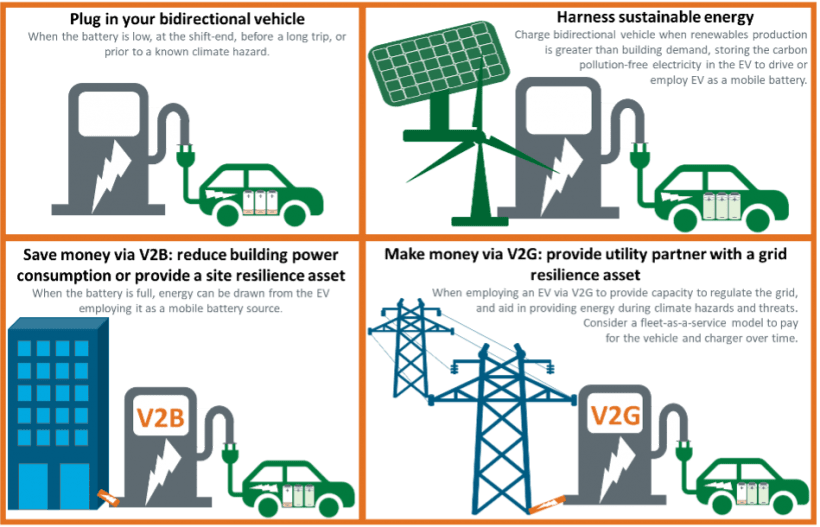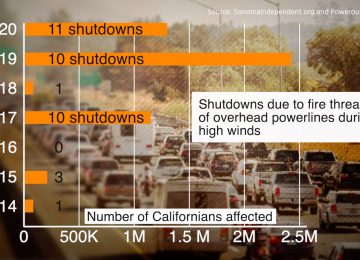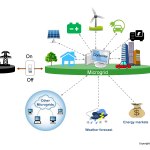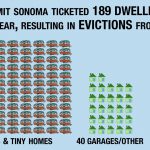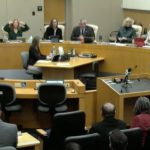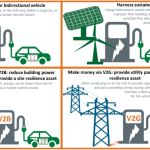SB 233, a California Senate bill that would mandate bidirectional charging capabilities in most electric vehicles sold starting in 2027, just passed in the Senate’s Energy, Utilities, and Communications committee by a vote of 12 to 1 on April 19.
Update June 1: On May 30 SB233 passed on the Senate floor with a floor vote of 28 to 9. The bill will now advance to the State Assembly. Information about how you can support the bill in the Assembly can be found at the bottom of this article.
Bidirectional charging turns electric vehicles (EV’s) into “power plants on wheels” that can be used to power the grid during peak hours, power homes during outages, and can even offset some of the cost of purchasing an EV.
But what is bidirectional EV charging, and why are environmental groups so excited about it?
Normally, when you plug an electric vehicle in, electricity flows into the EV’s batteries to charge them. If an electric vehicle has bidirectional charging capabilities, that means it can send that energy stored in the EV back through the charger, either into a home or into the transmission grid.
Generating enough electricity during peak hours is one of the biggest hurdles standing in the way of California’s climate goals, especially when it comes to electric vehicles. With bidirectional charging, the batteries in these same EVs could be used to power the grid during peak hours.
On September 6, 2022, a heat wave nearly caused a statewide blackout in California. It was only by turning on backup fossil fuel generators and operating the state’s natural gas power plants at full capacity that there weren’t more brownouts or lasting outages. If a fraction of the vehicles on the road had bidirectional charging, both the brownouts and the need to burn fossil fuels could have been avoided.
Ryan Schleeter of The Climate Center, the organization that is sponsoring SB 233, says “bidirectional charging reduces demand on the grid and makes energy more affordable for everyone.
If only 10 percent of the EVs on the road by 2030 have this capability, then they could put 6 gigawatts of energy back into the grid and easily meet the extra demand.”
The entire hourly load in September when rolling brownouts rocked the California grid was around 52 gigawatts and the cushion preventing a statewide blackout was less than 500 megawatts.
By adding extra capacity to the grid during peak hours, rates will be driven down at those most expensive times of peak demand. And for EV owners there are even more financial benefits. Much like solar panels, EV owners who feed energy back into the grid during peak hours could be paid for that electricity. If they charge their cars in off hours, and discharge back to the grid during peak hours, they will earn the difference between the two rates.
During power safety shut offs or other outages, EVs with bidirectional charging can also power homes to keep the lights on. Medical equipment, refrigerators, and computers could all be run from the power in an EVs batteries.
Ellie Cohen, CEO of The Climate Center gave the following testimony at the committee hearing. “As the climate crisis rapidly worsens and we face more extremes, we will face more power outages. The current plan to avoid blackouts is to fire up natural gas peaker plants —located primarily in lower-income, working-class communities — and to use propane or diesel generators, which further pollute our neighborhoods and climate. California can and must do better by using electric vehicles (EVs) as batteries on wheels. We can keep the lights on by using the EVs in our driveways, schoolyards, and city parking lots, and by paying EV owners for that power.”
Many homeowners who have solar panels are installing batteries, like Tesla’s powerwall. This will allow them to store electricity, allowing them to power their home even if the grid goes down. But an EV battery has four to five times as much energy as a powerwall, and its costs are already paid for with the purchase of the vehicle.
Tesla’s Powerwall 2 battery can store only 13.5kWh of electricity compared to around 60kWh of energy that is stored in the average EV.
Many EVs, like the Nissan Leaf, some Chevy Bolts and Hyundai’s Iconiq 5, already have bidirectional capability. EV batteries can range from 35kWh to 100kWh. This is enough energy to power an average home for about three days, or more if only powering essential appliances. Some Californian’s have already been using their EV’s to power their homes during outages.
The two biggest concerns that have been voiced in opposition to mandating bidirectional charging appear to be mostly unfounded.
One of the biggest concerns with any new technology mandate is increasing costs to consumers. Luckily, bidirectional charging in EVs requires little more than a software update. “Costs to consumers will be marginal. The Nissan Leaf is already one of the most affordable electric cars and it already has bidirectional charging,” said Schleeter.
The batteries in electric vehicles are some of their most expensive components. Naturally, some EV owners have also wondered whether charging and discharging the batteries regularly could shorten their life. Since the technology is so new, there haven’t been any real world use studies done, but modeling has shown that this concern is unfounded.
Batteries degrade most when they sit unused. This is why if you don’t start your car for a few weeks it will need a jump. Cars, even when used frequently, sit unused for the majority of their life. Batteries do degrade when they are cycled, as they are during charging and discharging, but this degradation is less than when they sit. Because of this fact, and that EV owners will recoup some of their electricity costs when putting power back into the grid, means that bidirectional charging will not shorten the lifespan of EV batteries.
Schleeter says that it’s important to mandate bidirectional charging now, before more EVs are purchased. If we wait until a few years down the line, it will be more expensive to upgrade the cars on the road.
With California’s mandate that 100% of new vehicles sold in 2035 must be zero emission vehicles, and that starting in 2026, 35% of new vehicles sold must be zero emission, it is important that these millions of EVs coming on the market come equipped with bidirectional charging.
While it is still very early in the legislative process, Schleeter says that the Climate Center is hopeful the bill will pass. “SB 233 has broad support. Avoiding power outages is a high priority for the governor and legislators. And Nancy Skinner is an accomplished and experienced leader.”
Robert Gammon, Senator Skinner’s press secretary, explained that the next hurdle for the bill is the Senate Transportation Committee on April 25th [editor note: the bill passed in the transportation committee with a 12 to 1 vote. The bill will go to the Senate Appropriations Committee next]. Gammon stated that the bill originally mandated that both EVs and EV charging infrastructure – whether in homes or chargers – were to have bidirectional capacity. Based on letters of opposition and Utilities’ Committee staff recommendations, the bill was amended to remove the mandate for electric charging infrastructure. Instead of a mandate on charging infrastructure, the bill will now instruct the California Energy Commission and CARB to study how best to move forward with bidirectional charging in homes.
While many groups are in support of the bill, only 4 have opposed it. Most of this opposition was leveled at the charging equipment mandate that has been stricken from the current version of the bill. It remains to be seen whether there will be any sustained opposition in the Appropriations Committee, and how the bill fares if it reaches the Senate floor later in the year. The Transportation Committee voted to pass the bill on April 25.
In March, UN Secretary General Antonio Guterres wrote that we must accelerate our efforts combating climate change “radically transforming our energy and transportation systems, breaking our addiction to fossil fuels, and embracing a just transition to renewable energy. [Developed and developing countries must] adapt to a renewable future, build resilience against extreme weather events, and address the loss and damage resulting from climate change.”
Bidirectional charging and SB233 are a clear example of the kind of innovation and transformation of the energy infrastructure that is called for. And Californian’s have first hand experience of the need for resilience against the climate driven fires that have wracked our state.
If you want to help pass SB 233, follow this link and fill out the form at the bottom of the page to contact your local legislators.
This article has been updated to show that SB 233 passed in the Transportation Committee on April 25,


